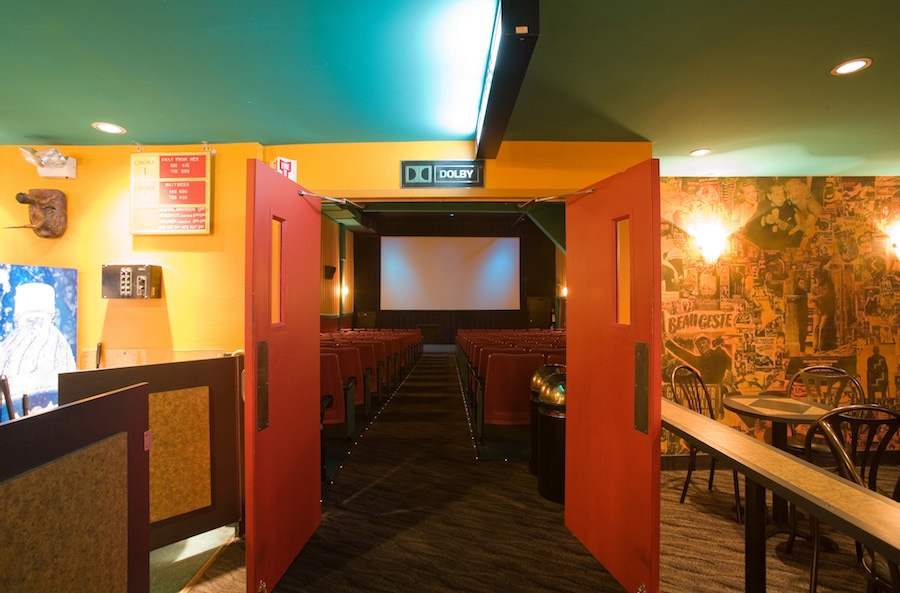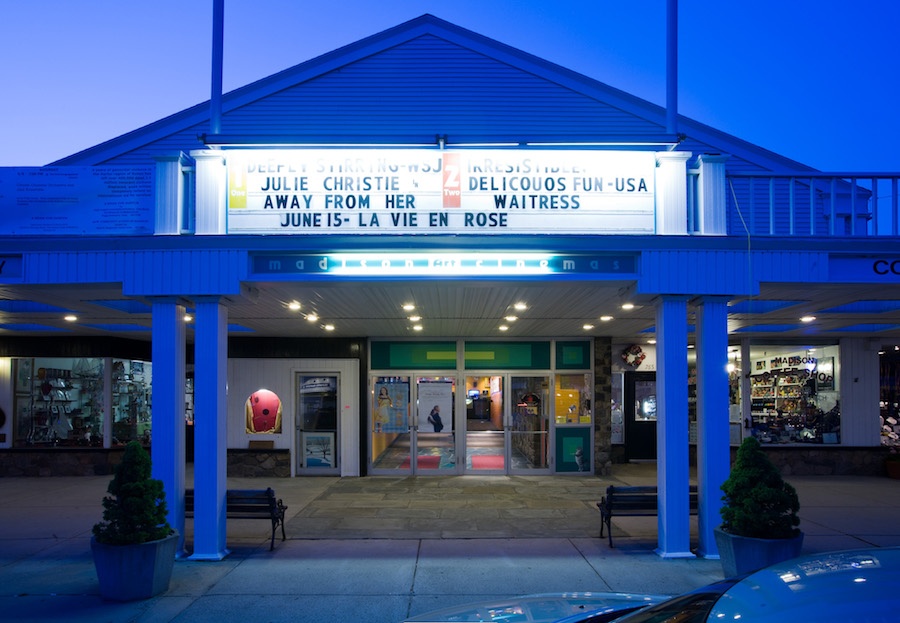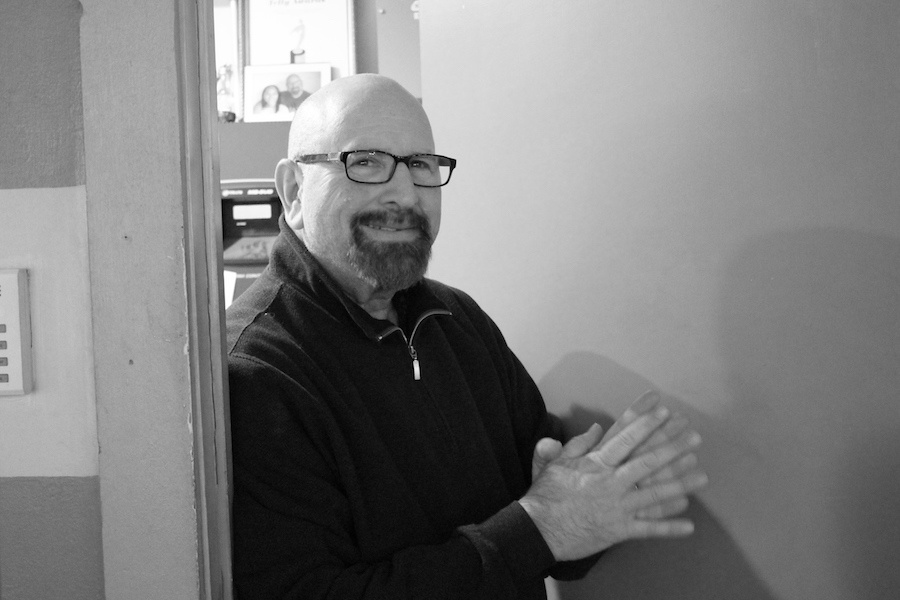
Greater New Haven | Madison Art Cinemas | Movies | Arts & Culture
 Between January and May of 1999, New Havener Arnold Gorlick renovated the Madison Art Cinemas, making adjustments to the seats, sound quality and appearance that he hoped would bring visitors in in droves. Arnold Gorlick Photo.
Between January and May of 1999, New Havener Arnold Gorlick renovated the Madison Art Cinemas, making adjustments to the seats, sound quality and appearance that he hoped would bring visitors in in droves. Arnold Gorlick Photo.
The question had been about how a movie theater can survive in the age of Netflix. But over coffee on a recent weekend, New Havener Arnold Gorlick was building a list to get to the answer.
Good coffee and expresso. New Haven’s now-defunct York Square Cinema, his first point of contact for New Haveners who are now close friends. Director Agnès Varda’s Faces Places, his favorite film of 2017. His great admiration—and burgeoning acquaintanceship—with writer and director Guillermo del Toro, who he met last year at the Toronto International Film Festival (TIFF).
They all lead to an unconditional love for Madison Art Cinemas, of which he is the current owner and operator.
 Thomas Breen Photo.
Thomas Breen Photo.
Standing proudly across from R.J. Julia Booksellers on Madison’s main drag, Madison Art Cinemas first opened in 1912, as a single-screen venue called Bonoff’s Madison Theatre. In 1977 it was purchased by the Australian company Hoyts Theatres, which twinned the theater, making it a double-screen venue.
Hoyts faltered economically in the 1990s, and began selling off acquisitions in Connecticut. When the company closed and walked away from the theater in 1998, Gorlick was there to keep the building going as a cinema. After major renovations, the space reopened in May 1999 under its current name.
There’s a long, winding history there. Long before Madison Art Cinemas, Gorlick was a kid in New York, growing up in Brooklyn’s Flatbush neighborhood with a love for film. In the 1950s and 60s, he watched in wonder as the grey, slick film reels spun fiction into art.
While attending Southampton College (the campus now belongs to Stony Brook Southampton) he became vice president of the film society. The president was his roommate, Peter Spodick, a native of New Haven. In early 1970, Peter's father Robert Spodick was running the Cheshire Cinema on Connecticut Route 10 and hired Gorlick.
“I worked six days a week for $110 a week but I loved it,” Gorlick recalled.
But the cinema fell on hard times, a trajectory that would ultimately lead to its closure in 2000. Gorlick stayed on for a while; in 1972, he became a member of the Projectionist Union, giving him a professional leg up. He was still working there when Robert opened a new venue called the York Square Cinema in downtown New Haven in 1970.

In March 1973, Gorlick left it to oversee the York Square Cinemas, sought out by the owners through negotiations with the Projectionist Union. The cinema had an automated projection system, which gave Gorlick more time outside of the projection booth, mingling with moviegoers and learning about the business end of things from Spodick.
In March of 1973, he became the managing director. It was blissful until it wasn’t, he said—Gorlick recalled that patrons began to think of him as the owner, and sought him out for pre-film recommendations and post-film conversations. He said it lead to tensions with Spodick, who ultimately fired Gorlick in May 1997 after 24 years at the York Square. The Arts Paper could not reach the Spodicks for comment on this article.
It could have been a disaster, Gorlick said—but it turned out to be a blessing in disguise. After his firing in May 1997, he began to look into having a theater of his own.
It was the late 1990s, a period of high turnover for New Haven real estate. The city was looking to revitalize the downtown area, and made him an offer to take over the old Macy’s building for a movie theater. But as Gorlick looked to move ahead with the offer, it fell through.
As it had once before, the timing still worked out: Hoyts Theatres could no longer afford its twin cinema in Madison. Encouraged by the location between the New Haven and New London markets and the business model of nearby R.J. Julia Booksellers, he put a plan into motion to open a dedicated art cinema based on his specifications. In January 1999, he signed a lease on the building.
“I found that the community leaned more toward a demographic that leaned more toward upwardly mobile and I could build an art theater that catered to women and a more mature clientele,” he said. “I believe that increasingly people lament the depersonalization of ordinary lives. I wanted to have a venue where people felt appreciated and known.”
“While the theater appeals to adult minds, teens appreciate it when they come,” he added.
Between January and May of 1999, Gorlick renovated the theater, gutting it completely, installing new seats and completely re-equipping the projection booth. He put his friend Vladimir Shpitalnik, a set designer at the Yale School of Drama, in charge of a complete redesign, reopening with a new facade and interior.
Since, he has implemented extra inducements to keep things interesting: a variety of Italian coffees and biscotti as well as the usual popcorn, candy and soda. He has installed an art gallery that Shpitalnik runs.
“I occasionally look at people’s work and then see if Vlad approves,” he said. "Vladimir is the curator of our art gallery. Period. If he does, the work goes up. Lately we’ve been showcasing the work of local talent.”
Now that the theater looks out onto Main Street with a new facade and interior, Gorlick said he also has a symbiotic relationship with his “neighbors”—the bookseller, the nearby restaurant owners, the townies.
“People come to see a movie, go to a restaurant or the bookstore. We’re good for each other,” he said.
As movies get harder to sell, he’s worked harder to compete. With approval from the town’s Planning & Zoning Commission, he has installed a LED marquee that can display information other than just what is playing. When moviegoers make their choice and come in, he is not afraid to make his opinions known. He said it’s something his most loyal customers have come to appreciate.
“Sometimes I’ll ask what they’re seeing,” he said. “If it’s one of the rare misfires we’re showing, I’ll tell them to see what’s playing on the other screen.”
He has also added his Sunday Cinema Club in 2000, a program then (and still) unique to Madison Art Cinemas in the state. Films are shown without the letting the audience know ahead of time what they will be seeing. Yale Professor John McKay and Yale Film Study Center Director Michael Kerbel take turns hosting.
Last year, Gorlick championed the film Moonlight, which went on to win the Academy Award for best picture.
"I spoke of a wide array of strategies to market Moonlight, primarily to promote advance press stories and reviews," he recalled. "I made curtain appearances before many shows began to speak on the importance to the audience to see Moonlight. I wrote an open letter to the movie-going public on my website and via email blasts to over 4000 of our e-newsletter subscribers. I also showed it to my Sunday Cinema Club to gauge their reaction to it and discuss it. I derived individual reactions to use as quotes in my open letter, e-newsletter and news stories."
“I don’t often do this but this was an important film and I thought it needed some help,” he added. “Something that the trailer for the film didn’t impart. We showed the film to our Sunday Cinema Club members. We had a full house and the response was absolutely ecstatic.”
In addition to post-film talk sessions for the Sunday films, he also provides response cards. Some films do extremely well—Moonlight received some of the best scores ever. Others, like The Florida Project, have received great critical acclaim just to be panned by the club.
As the Academy Awards drew near earlier this year, he showcased films he deemed worthy nominees. This year, he showed almost all of them concurrently: The Shape of Water and Three Billboards Outside Ebbing, Missouri during the day, followed in the evening by I, Tonya and Call Me by Your Name.
It’s a love for cinema that sometimes goes beyond professional bounds, and extends into personal ones. During his last visit to TIFF, Gorlick struck up a friendship with director Guillermo del Toro, heralded most recently for his 2017 film The Shape of Water. At a later film festival in New York, they began discussions about having del Toro come to Madison to speak about his films.
Almost two decades in, he’s got the town of Madison on his side. In April of 2012, he signed a lease with his landlord that goes to 2032 in five-year increments. He recalled being elated.
“Passion, I run on the passion for what I do and love, not for accolades or success,” he said. “The theaters been running for 19 years through ups and downs. I’ll keep doing this as long as I can.”

